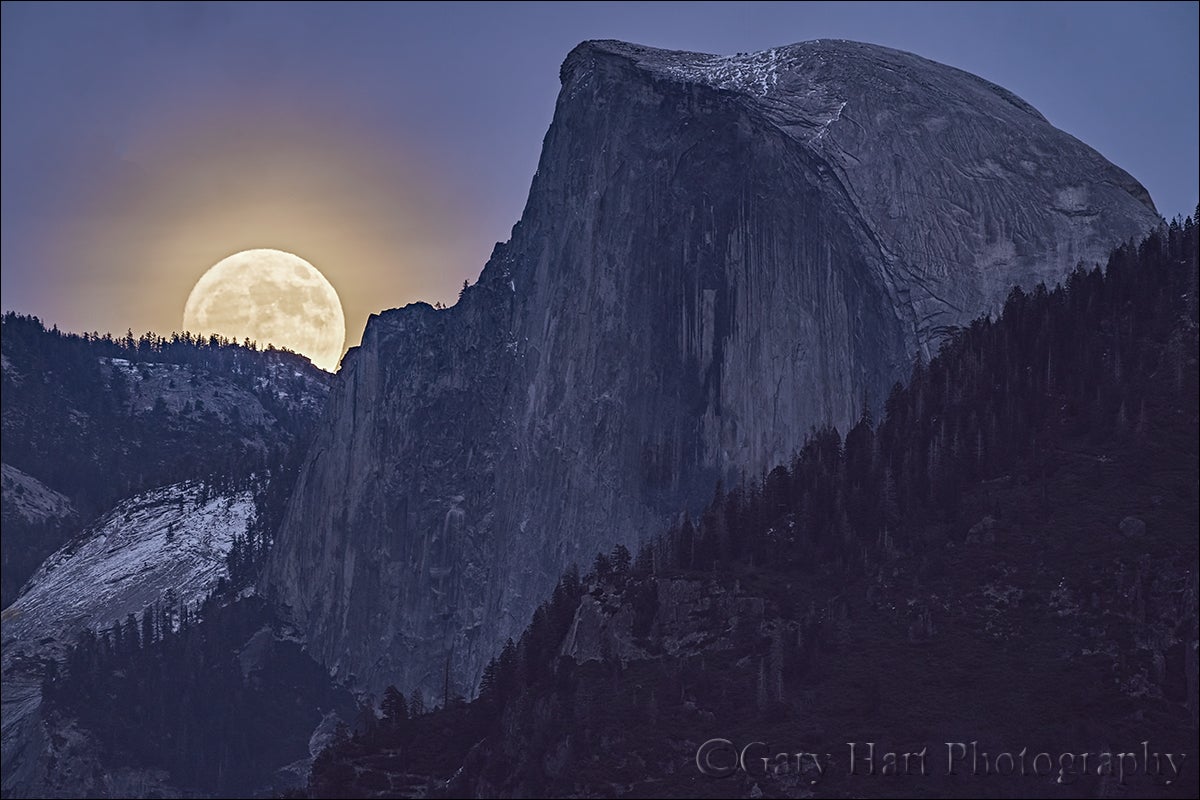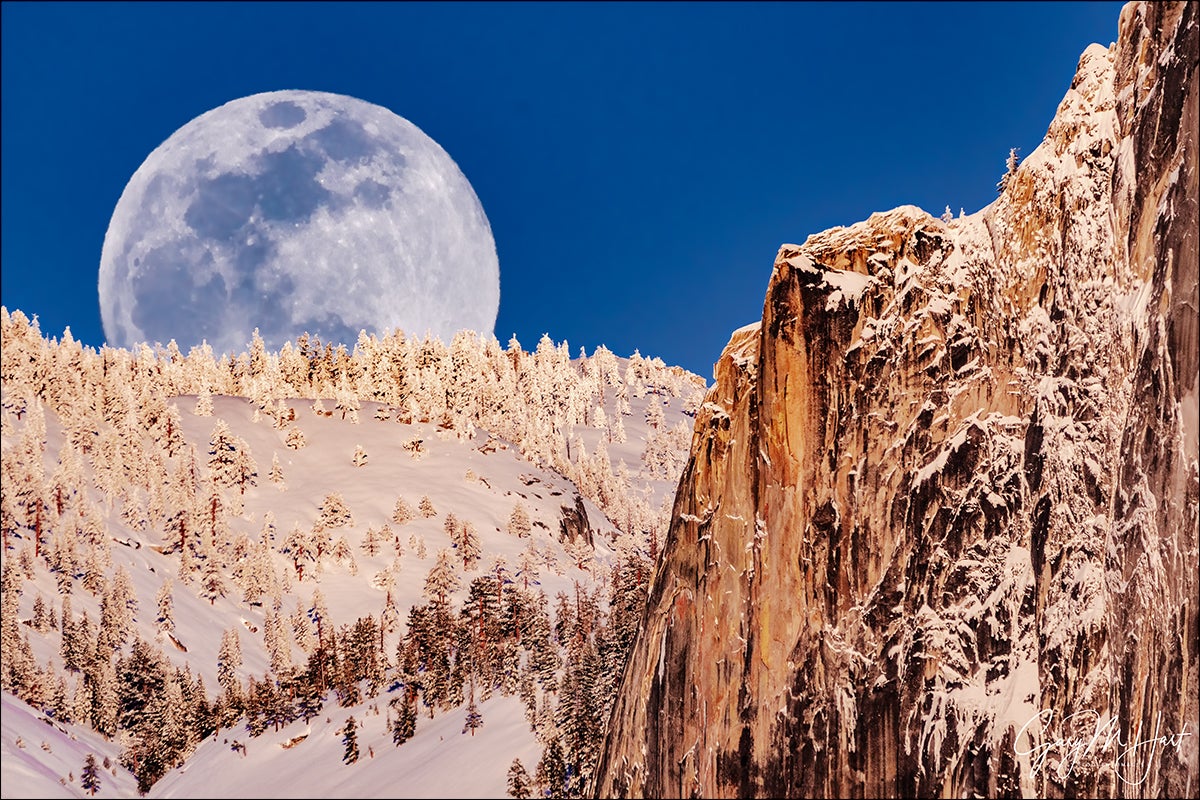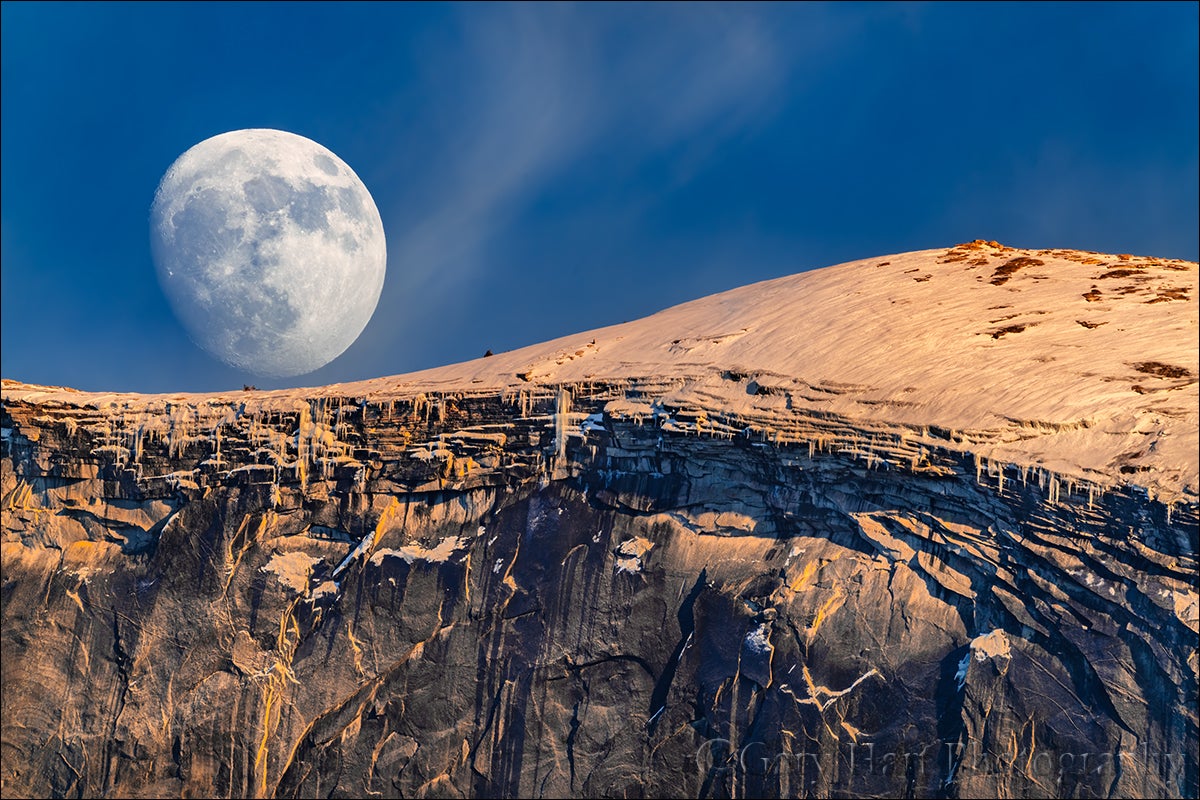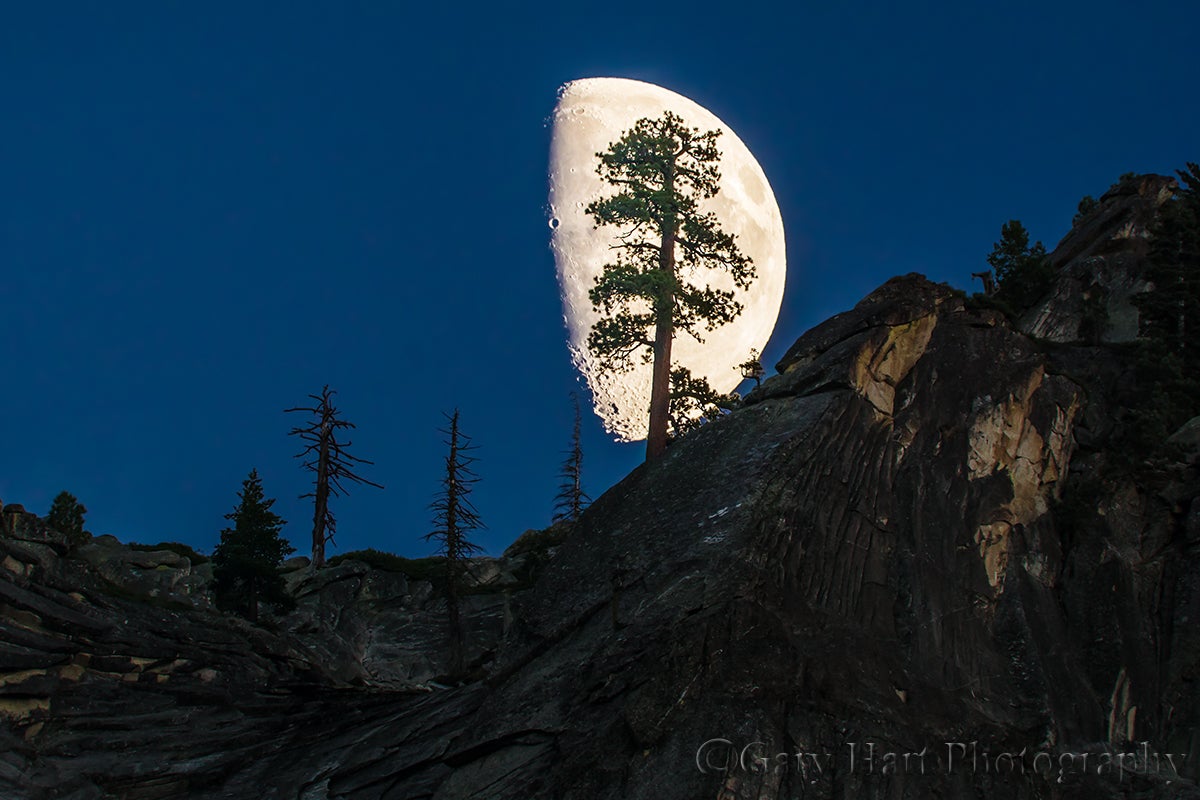After spending the day watching the clouds ebb and flow above Yosemite Valley, I breathed a sigh of relief when they departed for good about 30 minutes before sunset. Perched on a granite slab above Tunnel View, I watched the setting sun’s warming rays climb Yosemite’s vertical granite. Sunset here is always nice, but my prime goal this evening was the full moon that would rise above Yosemite Valley less than five minutes later.

Photo by Gary Hart. Sony α7R III. Sony 100-400mm f/4.5-5.6 G Master + 2X Teleconverter. 1/8-sec., f/11, ISO 400.
Without clouds to worry about and nothing to do but wait and watch, my anxiety moved on to the next thing—had I plotted the moonrise right? I’d checked and double checked more times than I could count, but there are a lot of moving parts in a telephoto moon shot, and the margin for error is pretty small. Adding to my anxiety, this would be the most extreme moon telephoto shot I’d ever attempted.
My rules for moon photography are simple: capture detail in both the moon and the landscape in one click (no blending of images for exposure, or to upsize or reposition the moon), and appreciate the moment.
The Right Lens For A Big Moon
I enjoy using the moon as a simple accent to a wide angle scene, but when possible, I also try to photograph the moon big, the bigger the better. And each time I do capture a big moon, I try to figure out how I might capture it even bigger the next time.
Despite media hyperbole each time a “supermoon” comes around, the size of the moon in an image is almost entirely a function of the focal length used to photograph it—super or not, photograph the moon at 16mm and it registers as a tiny dot; photograph it at 600mm (or larger) and the moon dominates your frame.

Photo by Gary Hart. Sony α6300. Sony 100-400mm f/4.5-5.6 G Master + 2X Teleconverter. 1/400-sec., f/11, ISO 200.
For the last several years my go-to big moon lens has been the Sony 100-400mm GM. I like this lens for its magnification and sharpness, and because it gives me focal length flexibility to pull back when I need to fit another foreground feature (or two). Alternately, while it’s too big to live in my bag fulltime, when I really want to go nuclear on the moon, I pack my Sony 200-600mm G lens.

Photo by Gary Hart. Sony α7R IV. Sony 200-600mm f/5.6-6.3 G. 1/25-sec., f/6.3, ISO 800.
Bigger still? The Sony 2X Teleconverter pairs wonderfully with both the 100-400mm and 200-600mm, giving me a focal length all the way out to 1200mm on my full frame bodies.

Photo by Gary Hart. Sony α7R IV. Sony 200-600mm f/5.6-6.3 G + 2X Teleconverter. 1/3-sec., f/13, ISO 400.
Camera Setup
The camera matters too. The greater the sensor’s resolution, the more I can crop to increase the size of the moon without obvious quality loss. Until recently, after maxing out my full frame focal length, I’d sometimes switch to my APS-C (1.5 crop) Sony α6300 for another 50% boost in moon size. But the Sony α7R IV in APS-C crop mode has more resolution than the α6300, so I’m now full frame, full time.
Another important camera consideration is dynamic range. Because a full moon rises at sunset and sets at sunrise (more or less), you’ll be photographing a daylight-bright moon above a foreground in deep twilight shadow. The better your camera’s dynamic range, the better you’ll be able to capture detail in the bright moon and foreground as the rest of the scene darkens.

Photo by Gary Hart. Sony α7R III. Sony 100-400mm f/4.5-5.6 G Master + 2X Teleconverter. 1/8-sec., f/11, ISO 400.
All of the current Sony bodies offer more than enough resolution and dynamic range, but in both categories, it’s pretty tough to beat the Sony α7R IV. (I’ve found that my α7R III is no slouch either.)
Be sure not to blow out the highlights in the bright moon as it's rising. You want to push your exposure just enough to keep all of that texture. One guideline to try as you’re dialing in the exposure is to use the “Sunny Day Rule” which sets your exposure as 1/ISO (for the shutter speed) at f/16. This works because it might be evening when you’re shooting on Earth, but it’s always a bright, clear, sunny day on the moon. From that base exposure, use your in-camera histogram and highlight alerts to adjust the exposure depending on haze in the atmosphere, etc., and to take advantage of your camera’s dynamic range.
One more thing: I wouldn’t dream of photographing an extreme telephoto moon without a sturdy tripod.
Location, Location, Location
Including a large moon in a landscape image requires more than just a long focal length. If big was all that mattered, you could attach your longest lens, point moonward, and fill the frame with the moon (not that there’s anything wrong with that). But without a landscape to go with your huge moon, no one would know whether you took the picture atop a glacier in New Zealand, on a granite ledge in Yosemite, or beside the garbage cans in your driveway.

Photo by Gary Hart. Sony α6300. 250mm. 1/8-sec., f/8, ISO 200.
Of course increasing the focal length to increase the size of your moon decreases the field of view correspondingly. One of the most difficult parts of pairing a large moon with a specific landscape subject is finding a vantage point distant enough to fit the terrestrial subject and the moon. For example, there are some great views of Half Dome on the east side of Yosemite Valley, but the longest focal length I can use there and still fit all of Half Dome is around 150mm.
Coordinating all the moving parts (moon phase and position, foreground subject alignment, subject distance, and rise/set timing) requires a little advance work. Once I choose a subject to go with my moon, I try to find the most distant view of that subject. Then I need to figure out when that location, my distant subject, and the moon all align.
When I started photographing the moon, in the days before smart phones and apps that do the heavy lifting, I had to refer to tables to get the moon’s phase and position in the sky at a specific date and time, manually plot the alignment on a map, then apply the Pythagorean theorem to compute the timing of the moon’s arrival above (or disappearance behind, for sunrise) the terrain.

Photo by Gary Hart. Sony α6300. 250mm. 1/3-sec., f/8, ISO 100.
Today there are countless apps that will do this for you. Apps like The Photographer’s Ephemeris and Photo Pills (to name just two of many) are fantastic tools that give photographers access to all the pertinent mapping and moonrise/set data for any location on Earth. They have a bit of a learning curve (so don’t wait until the last minute to plan your shoot), but they’re infinitely easier than my old-fashioned way.
Timing
The longer the focal length, the sooner the moon rises out of the frame, so to simultaneously capture the moon and a landscape scene using a telephoto lens, the moon must be very close to the horizon. And simply finding the moon on the horizon isn’t enough — while the moon can be seen in full daylight, it needs contrast only possible around sunrise and sunset to really stand out.

Photo by Gary Hart. Sony α7R II. Sony 100-400mm f/4.5-5.6 G Master + 2X Teleconverter. 1/25-sec., f/11, ISO 100.
The darker the sky, the more prominent the moon, but also the darker the landscape, which makes it more difficult to capture detail in the moon without losing the shadowed foreground to complete blackness. My rule of thumb is to catch a full (or nearly full) moon near the horizon in the 30-minute window that starts about 15 minutes before sunrise/sunset and ends about 15 minutes after (this window will vary depending on your latitude, your camera’s dynamic range, and your proficiency managing exposure.)
All published moon and sun rise/set times assume a flat horizon. The angle from your location to the horizon determines when it will rise at your position. Because a full moon rises around sunset and sets around sunrise, and the moon on average rises and sets a little less than an hour later each day, I find that often the best time to photograph a full moon rising in the east at sunset is the day before it’s full. Conversely, the day after the moon is full is often the best time to photograph it setting in the west at sunrise.
Depth Of Field
Extreme focal lengths mean extremely limited depth of field. Depth of field isn’t a concern when Half Dome is your closest subject and it’s 10 miles distant, but when your foreground is an oak tree on a hill that’s a mile away, you absolutely need to consider the hyperfocal distance.
For example, the full frame hyperfocal distance at 800mm and f/11 is more than a mile (look it up). Focus on a tree that’s a mile away and the moon will be soft, focus on the moon and the tree is soft. But if you can focus on something that’s a little beyond the tree, at maybe one-and-a-half miles away, the image will be sharp from front to back.

Photo by Gary Hart. Sony α6000. 600mm. 1/25-sec., f/8, ISO 400.
When I’m not sure of my subject distance, I estimate as best I can, focus on a point beyond my foreground subject, then review my image magnified to check sharpness. If my focus point is in my frame, great, but I won’t hesitate to remove my camera from the tripod to focus on something elsewhere that’s the right distance (if you do this, to prevent refocusing, be sure you use back-button focus or are in manual focus mode when you click your shutter). It’s always best to get the focus sorted out before the moon arrives, a good reason to arrive at a new location early.
Putting It All Together
I look for big-moon locations everywhere I go. My criteria are a prominent subject that stands out against the sky, and a distant east- or west-facing vantage point. Over the years I’ve assembled a mental database of potential subjects ranging from hilltop oaks in the foothills near home, to landscape icons like Half Dome, Mt. Whitney, and Zabriskie Point (Death Valley).
With a terrestrial subject identified, I do my plotting and mark my calendar for the day I want to be there. That often means waiting a year or more for the alignment I want. The location I monitor most closely for a possible full moon alignment is Yosemite, which has a wealth of prominent subjects and distant vistas.
Late in 2018 I determined that on an evening in February of 2020 a full moon would rise, just a few minutes after sunset, between El Capitan and Half Dome and directly behind Clouds Rest. I immediately blocked the date in my calendar, and a few weeks later scheduled a photo workshop that would include that day (because it’s always more fun to share the experience with other enthusiastic photographers).
Which is how I found myself on a granite slab 400 feet above Yosemite Valley, holding my breath and waiting for the moon to appear. Truth be told, most of my anxiety was for my group, who had been looking forward to this moonrise since enrolling in the workshop. I’d have been disappointed as well if clouds had blocked the moon (or, heaven forbid, I’d miscalculated), but I’d done it before and would have many more opportunities.
Because extreme dynamic range makes exposing for a post-sunset moonrise very tricky, I had used the nearly full rising moons on the workshop’s first two nights to teach my group to trust their camera’s exposure aids (histogram and highlight alert) and ignore the image on the LCD (kind of like flying a plane on instruments). So with two moonrises already under their belts, I was confident everyone was ready.
I was ready too. I’d set up two tripods: mounted on one was my Sony α7R III and 100-400 GM lens; on the other tripod was my Sony α7R IV and 200-600mm, doubled by the Sony 2X Teleconverter: 1200mm. But I wasn’t done. Normally I shoot full frame and crop later (for more compositional flexibility), but just for fun, on this night I decided to put my camera in APS-C mode so I could compose the scene at a truly ridiculous 1800mm (at 26 megapixels!) – I just couldn’t resist seeing what 1800mm looked like in my viewfinder. Equipment ready and knowing exactly where the moon would appear, while I waited I played with compositions and checked focus, and encouraged the group to do the same.

Photo by Gary Hart. Sony α7R IV. Sony 200-600mm f/5.6-6.3 G + 2X Teleconverter. 1/20-sec., f/13, ISO 200.
When the brilliant sliver of the moon’s leading edge peaked above Cloud’s Rest at 5:33 I exhaled and started clicking. It is truly startling to realize how quickly the moon moves through the frame at 1800mm, so the next few minutes were kind of a blur (except my images, thankfully). Refining compositions and tweaking exposure and focus on two bodies, I felt like the percussionist in a jazz band, but I somehow managed to track the moon well enough to keep it framed in both cameras. I also took a few beats between frames to simply marvel at the view.
Before the moon had completely cleared Cloud’s Rest, the darkening sky started to pink-up nicely—underexposing slightly to avoid blowing out the moon’s highlights enriched this color further. In less than three minutes the moon rose out of my frame and I had to widen my composition.
The framing you see here is exactly what I saw in my viewfinder (not cropped in post-processing), a full 1800mm equivalent that nearly fills the frame top-to-bottom. I’ve done this long enough not to claim I’ll never need a bigger lens, but I’m definitely satisfied — for now.



